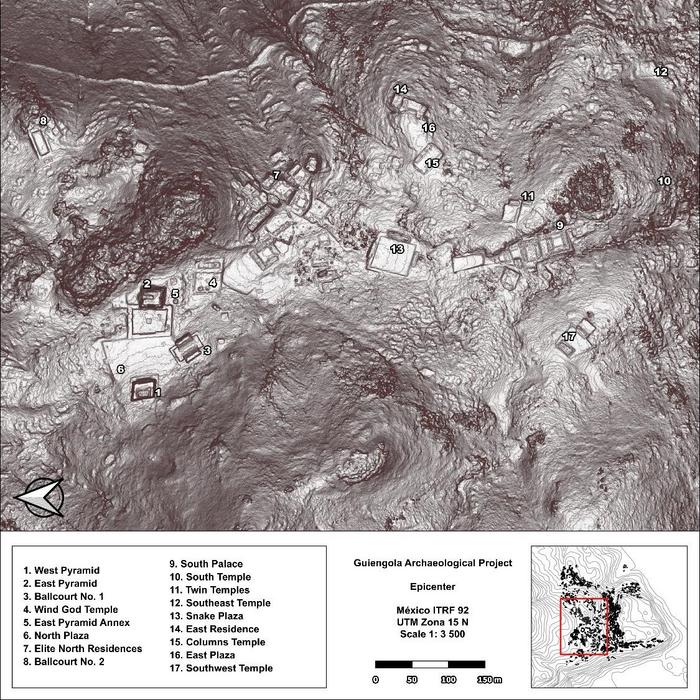Remote sensing tools yield insights into abandoned pre-Columbian Mexican city
Awareness of the Zapotecs’ level of political and social organization stands to shed light on their level of agency in negotiating with the Spanish
McGill University
image:
Serpent sculpture from the serpent plaza found by an earlier archaeological expedition and now in the Oaxacan hall in the National Museum of Anthropology in Mexico City.
view moreCredit: Pedro Guillermo Ramón Celis
A McGill University researcher has discovered that Guiengola, a 15th century Zapotec site in southern Oaxaca, Mexico, which had been thought to be simply a fortress where soldiers were garrisoned, was in fact a sprawling, fortified city. It covered 360 hectares, with over 1,100 buildings, four kilometres of walls, a network of internal roads and a clearly organized urban layout with temples and communal spaces such as ballcourts, and the elites and commoners lived in separate neighbourhoods.
According to Pedro Guillermo Ramón Celis, a Banting postdoctoral researcher in McGill’s Department of Anthropology and the author of a recent article in Ancient Mesoamerica, the evidence strongly suggests the city was abandoned just before the Spanish arrived, and that its people moved just 20 kilometres away to Tehuantepec, a small city where their descendants still live today.
Ramón Celis said investigating how the Mesoamerican city was organized on the eve of the Spanish conquest is just the first step. He said he is convinced that as work on Guiengola advances, it will give researchers a better sense of the Zapotecs’ level of political and social organization, and thus a greater understanding of their level of agency in negotiating with the Spanish.
The finding was made by using a remote sensing tool known as lidar (light detection and ranging). Lidar relies on pulsing laser beams, in a process akin to sonar, to provide precise, detailed, three-dimensional topographic information about what is on the earth’s surface, below the dense forest canopy.
“My mother’s family is from the region of Tehuantepec which is about 15 km from the site, and I remember them talking about it when I was a child. It was one of the reasons that I chose to go into archaeology,” Ramón Celis said. “Although you could reach the site using a footpath, it was covered by a canopy of trees. Until very recently, there would have been no way for anyone to discover the full extent of the site without spending years on the ground walking and searching. We were able to do it within two hours by using remote sensing equipment and scanning from a plane.”
By analyzing the data generated by the scans and using the Geo Analytic laboratory at McGill, Ramón Celis has been able to map the size and the layouts of the remaining built structures and infer their use based on the artifacts found at the locations.
To explore how power was distributed in the city, he has calculated how much building space was given over to elite areas such as the temples and ballcourts, for example, compared to what was built in the areas used by commoners. Ballcourts were built in Mesoamerica for the purpose of practicing a ritual ballgame, and represent both the underworld and fertility, since they are a way of connecting with the ancestors and seeds grow below the soil, where the underworld is found.
Ramón Celis added, “Because the city is only between 500 and 600 years old, it is amazingly well preserved, so you can walk there in the jungle, and you find that houses are still standing… you can see the doors… the hallways… the fences that split it from other houses. So, it is easy to identify a residential lot. It's like a city frozen in time, before any of the deep cultural transformations brough by the Spanish arrival had taken place.”
The research: “Airborne lidar at Guiengola, Oacaxa: Mapping a Late Postclassic Zapotec city” by Pedro Guillermo Ramón Celis was published in Ancient Mesoamerica
DOI: https://doi.org/10.1017/S0956536124000166
The funding: Wenner-Gren Foundation, Indiana University College of Arts and Sciences and now the Canadian Social Sciences and Humanities Research Council.
Public and Private spaces in Guiengola 
North of the centre of the site it is possible to observe public spaces, such as the North Plaza, and private elite spaces, such as the Ballcourt No.2
Credit
Pedro Guillermo Ramón Celis
View of Guiengola’s North Plaza from above, the only area not covered by the tree canopy
Credit
Pedro Guillermo Ramón Celis
Lidar scan showing the Civic and Ceremonial Center (left) and the commoner areas (right), split by a defensive wall (centre)
Credit
Pedro Guillermo Ramón Celis
Journal
Ancient Mesoamerica
Article Title
Airborne lidar at Guiengola, Oacaxa: Mapping a Late Postclassic Zapotec city